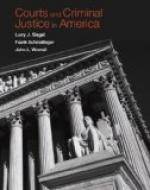It frequently happens that an entire case will rest upon the testimony of a single witness whose absence from the jurisdiction would prevent the trial. An instance of such a case was that of Albert T. Patrick, for without the testimony of his alleged accomplice—the valet, Jones—he could not have been convicted of murder. The preservation of such a witness and his testimony thus becomes of paramount importance, and rascally witnesses sometimes enjoy considerable ease, if not luxury, at the expense of the public while waiting to testify. Often, too, a case of great interest will arise where the question of the guilt of the accused turns upon the evidence of some one person who, either from mercenary motives or because of “blood and affection,” is unwilling to come to the fore and tell the truth. A striking case of this sort occurred some ten years ago. The “black sheep” of a prominent New York family forged the name of his sister to a draft for thirty thousand dollars. This sister, who was an elderly woman of the highest character and refinement, did not care to pocket the loss herself and declined to have the draft debited to her account at the bank. A lawsuit followed, in which the sister swore that the name signed to the draft was not in her handwriting. She won her case, but some officious person laid the matter before the district attorney. The forger was arrested and his sister was summoned before the grand jury. Here was a pleasant predicament. If she testified for the State her brother would undoubtedly go to prison for many years, to say nothing of the notoriety for the entire family which so sensational a case would occasion. She, therefore, slipped out of the city and sailed for Europe the night before she was to appear before the grand jury. Her brother was in due course indicted and held for trial in large bail, but there was and is no prospect of convicting him for his crime so long as his sister remains in the voluntary exile to which she has subjected herself. She can never return to New York to live unless something happens either to the indictment or her brother, neither of which events seems likely in the immediate future.
Perhaps, if the case is one of shooting, the weapon has vanished. Its discovery may lead to the finding of the murderer. In one instance where a body was found in the woods with a bullet through the heart, there was nothing to indicate who had committed the crime. The only scintilla of evidence was an exploded cartridge—a small thing on which to build a case. But the district attorney had the hammer marks upon the cap magnified several hundred times and then set out to find the rifle which bore the hammer which had made them. Thousands of rifles all over the State were examined. At last in a remote lumber camp was found the weapon which had fired the fatal bullet. The owner was arrested, accused of the murder, and confessed his crime. In like manner, if it becomes necessary to determine where a typewritten document was prepared the letters may be magnified, and by examining the ribbons of suspected machines the desired fact may be ascertained. The magnifying glass still plays an important part in detecting crime, although usually in ways little suspected by the general public.




